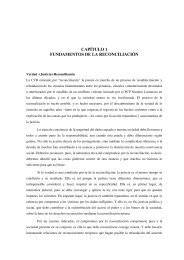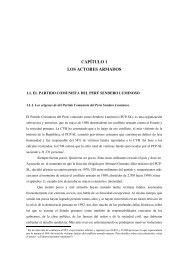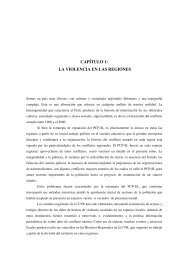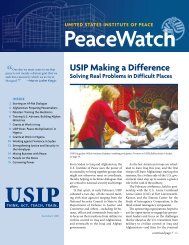Talking to Groups that Use Terror.pdf - United States Institute of Peace
Talking to Groups that Use Terror.pdf - United States Institute of Peace
Talking to Groups that Use Terror.pdf - United States Institute of Peace
You also want an ePaper? Increase the reach of your titles
YUMPU automatically turns print PDFs into web optimized ePapers that Google loves.
Step 1: Assess the Potential for NegotiationsUndercutting ModeratesIf media<strong>to</strong>rs and negotia<strong>to</strong>rs who support engagement risk looking foolishwhen talks lead nowhere, the moderates within a PAG who championedthe idea <strong>of</strong> talking risk being sidelined within or sanctioned by theirorganization, or even murdered by their harder-line colleagues. Whentalks lead nowhere, the door opens for hard-liners <strong>to</strong> assume or reassumecontrol <strong>of</strong> policy within the PAG. Greater violence is usually the result.Talks with the <strong>United</strong> Kingdom in the early 1970s discredited oldermembers <strong>of</strong> the IRA and led <strong>to</strong> the rise <strong>of</strong> a younger, more radical cadre whocontinued violence with little progress for over twenty years. The roots <strong>of</strong> therise <strong>of</strong> Hamas and its ability <strong>to</strong> oust the PLO from power in the Gaza Striplie in the failure <strong>to</strong> implement the Oslo Accords, which the PLO hadnegotiated but which Hamas had always opposed.Creating Splinter MovementsBut while deadlock is <strong>of</strong>ten costly, progress in the talks can be equally oreven more damaging in cases where the internal coherence <strong>of</strong> the PAGis weak. Those negotiating for the PAG may have control over or thesupport <strong>of</strong> most members <strong>of</strong> their group, but the closer a negotiatedsettlement comes, the more likely it is <strong>that</strong> a splinter group opposed <strong>to</strong>the making <strong>of</strong> any concessions will break <strong>of</strong>f and create a yet more violentterrorist entity. In other cases, the PAG negotia<strong>to</strong>rs do not even controlthe majority <strong>of</strong> the group’s members and cannot deliver their acceptance<strong>of</strong> any negotiated agreement, so any concessions granted in exchange fortalks become worthless.Giving <strong>Terror</strong>ists Breathing SpaceSome terrorist groups may enter talks and even proclaim a cease-fire withno intention <strong>of</strong> permanently renouncing violence. Because terroristgroups grow stronger by demonstrating their staying power, simplybuying time in the face <strong>of</strong> an aggressive government counterterrorismcampaign can be immensely valuable <strong>to</strong> them.The Liberation Tigers <strong>of</strong> Tamil Eelam repeatedly used cease-fires <strong>to</strong>rearm and regroup for their next <strong>of</strong>fensive. In 1998 the Basque separatistmovement ETA announced a cease-fire because <strong>of</strong> outrage—including21









